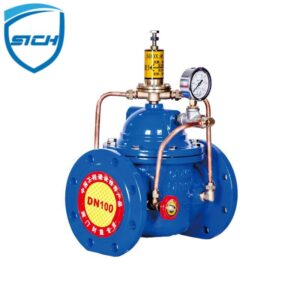The design of a fire fighting relief valve is crucial in optimizing flow characteristics and pressure control to ensure efficient and effective operation.
Here’s how the design contributes to these aspects:
- Flow Path Geometry: The internal flow path geometry of the relief valve is carefully engineered to minimize flow restrictions and turbulence, allowing for smooth and uninterrupted flow of water or fire suppression agent through the valve. This design feature helps optimize flow characteristics by reducing pressure drop and maximizing flow capacity, ensuring rapid discharge of water during firefighting operations.
- Valve Seat and Disc Configuration: The valve seat and disc configuration are designed to provide precise pressure control and modulation. The valve disc is typically designed to move freely within the valve body, allowing it to open and close in response to changes in system pressure. The geometry and material of the valve seat are selected to ensure a tight seal when the valve is closed, preventing leakage and maintaining system integrity.
- Adjustable Spring Tension: Many fire fighting relief valves are equipped with adjustable spring tension mechanisms that allow for precise calibration of the valve’s opening pressure. By adjusting the tension of the spring, operators can set the desired pressure at which the valve opens to relieve excess pressure in the system. This feature enables fine-tuning of pressure control according to specific application requirements.
- Pilot Control Systems: Some fire fighting relief valves utilize pilot control systems to enhance pressure control accuracy. China fire fighting relief valve manufacturer These systems consist of pilot valves or actuators that sense system pressure and modulate the opening and closing of the main relief valve accordingly. Pilot control systems provide real-time feedback and adjustment, ensuring consistent pressure regulation under varying operating conditions.
- Pressure Relief Mechanism: The pressure relief mechanism of the valve is designed to activate smoothly and rapidly when the system pressure exceeds the preset threshold. This mechanism may involve the use of springs, diaphragms, or other actuating elements that respond quickly to changes in pressure. The design of the relief mechanism ensures reliable and predictable pressure control, preventing overpressurization and system damage.
- Flow Regulation Features: Some fire fighting relief valves are equipped with flow regulation features such as throttling devices or bypass ports that allow for additional control over flow rates. These features enable operators to adjust flow rates within the system to match specific firefighting requirements, such as controlling nozzle flow or preventing excessive water discharge.
- Materials and Construction: The materials and construction of the relief valve are carefully selected to withstand high-pressure environments and harsh operating conditions. High-quality materials such as stainless steel, brass, or durable polymers are used to ensure long-term reliability and performance. The robust construction of the valve withstands the forces exerted by high-pressure water flow, maintaining structural integrity and preventing leakage.
Overall, the design of a fire fighting relief valve is optimized to provide precise pressure control and efficient flow characteristics, ensuring effective operation in firefighting applications. By incorporating features such as optimized flow paths, adjustable pressure settings, pilot control systems, and reliable pressure relief mechanisms, these valves contribute to the safe and efficient management of water flow in fire suppression systems.

How does the design of a fire fighting relief valve optimize flow characteristics and pressure control?
